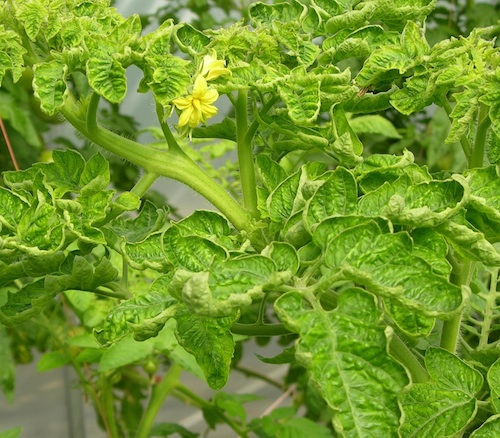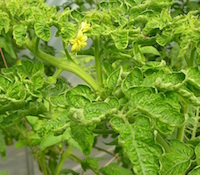University of Georgia Cooperative Extension agents, like myself, are getting several phone calls about the leaves on homegrown tomato plants curling and rolling inward. Curling or rolling of tomato leaves can be caused by various factors including environmental stresses, a virus or herbicide damage.
To determine which factor is causing the problem, it pays to take a close look at the plant. Which leaves are rolling – old leaves, new leaves or all leaves? What direction do the leaves roll – upward or downward? Are any other parts of the plant, including fruit, exhibiting symptoms?
Physiological leaf roll
Excessive moisture and nitrogen, heat, drought, severe pruning, root damage and transplant shock are some of the environmental factors that can cause the leaves to roll in tomatoes. Initial symptoms are usually noticed in the lower leaves with an upward cupping of the leaves and are followed by an inward lengthwise rolling of the leaflets toward the midvein.
Affected leaves tend to become thick and have a leathery texture, but retain a normal, healthy green color. Over time, all of the leaves on the plant may be affected.
The symptoms on tomatoes are very similar to those of a viral potato disease known as leaf roll, but the leaf roll of tomatoes is not often caused by virus infection.
Indeterminate tomato varieties tend to exhibit physiological leaf roll more often than determinate tomato varieties. Some varieties are more sensitive to leaf roll than others, but none are completely resistant.
While this condition can occur at any time in the growing season, it usually occurs in late spring or early summer. The good news is that the condition has little impact on tomato fruit production and plant growth.
Following these control practices may help avoid or reduce leaf roll in tomatoes:
- Plant tomatoes in well-drained soil.
- Fertilize according to soil test recommendations and do not over fertilize (especially with nitrogen).
- Avoid deep and close cultivation (especially in dry weather).
- Maintain uniform soil moisture by watering plants during dry periods and mulching around the plants.
Viral infection
While not as common as leaf roll caused by environmental factors, viral infections can also cause leaf roll. There are no treatments for virus-infected plants. Removing and destroying the plant is recommended.
Herbicide injury
Tomatoes are very sensitive to the herbicide 2,4-D. When tomato plants are exposed to 2,4-D, typical symptoms include downward rolling of leaves and twisted growth. In addition, stems may split and fruit may be misshapen. Plant survival depends on the level of exposure.
Always be very careful when spraying an herbicide as it may drift much further than anticipated.
For more information on growing tomatoes and other fruits and vegetables, search UGA Extension publications at www.caes.uga.edu/publications/.








